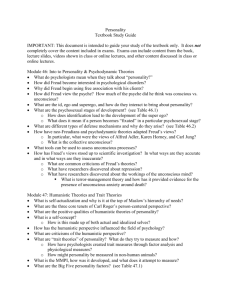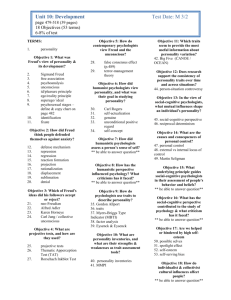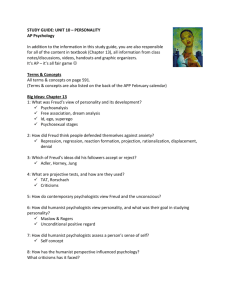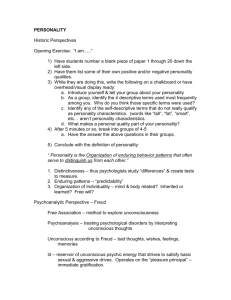12 CHAPTER Personality Chapter Preview Personality is one`s
advertisement
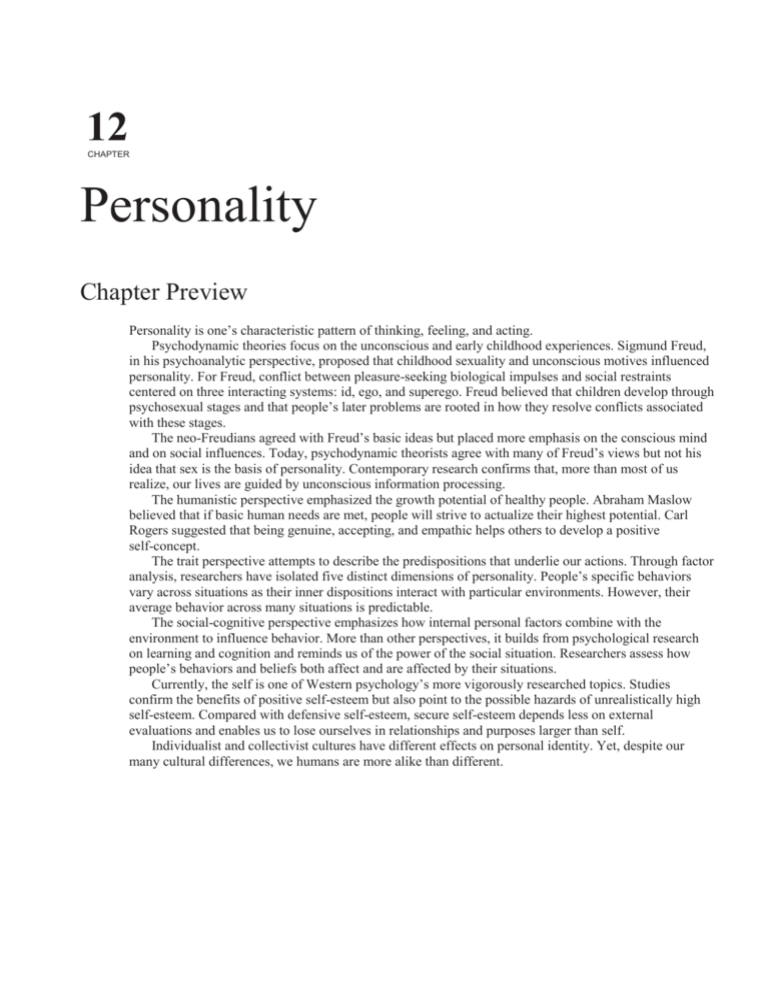
12 CHAPTER Personality Chapter Preview Personality is one’s characteristic pattern of thinking, feeling, and acting. Psychodynamic theories focus on the unconscious and early childhood experiences. Sigmund Freud, in his psychoanalytic perspective, proposed that childhood sexuality and unconscious motives influenced personality. For Freud, conflict between pleasure-seeking biological impulses and social restraints centered on three interacting systems: id, ego, and superego. Freud believed that children develop through psychosexual stages and that people’s later problems are rooted in how they resolve conflicts associated with these stages. The neo-Freudians agreed with Freud’s basic ideas but placed more emphasis on the conscious mind and on social influences. Today, psychodynamic theorists agree with many of Freud’s views but not his idea that sex is the basis of personality. Contemporary research confirms that, more than most of us realize, our lives are guided by unconscious information processing. The humanistic perspective emphasized the growth potential of healthy people. Abraham Maslow believed that if basic human needs are met, people will strive to actualize their highest potential. Carl Rogers suggested that being genuine, accepting, and empathic helps others to develop a positive self-concept. The trait perspective attempts to describe the predispositions that underlie our actions. Through factor analysis, researchers have isolated five distinct dimensions of personality. People’s specific behaviors vary across situations as their inner dispositions interact with particular environments. However, their average behavior across many situations is predictable. The social-cognitive perspective emphasizes how internal personal factors combine with the environment to influence behavior. More than other perspectives, it builds from psychological research on learning and cognition and reminds us of the power of the social situation. Researchers assess how people’s behaviors and beliefs both affect and are affected by their situations. Currently, the self is one of Western psychology’s more vigorously researched topics. Studies confirm the benefits of positive self-esteem but also point to the possible hazards of unrealistically high self-esteem. Compared with defensive self-esteem, secure self-esteem depends less on external evaluations and enables us to lose ourselves in relationships and purposes larger than self. Individualist and collectivist cultures have different effects on personal identity. Yet, despite our many cultural differences, we humans are more alike than different. Chapter Guide Introductory Exercise: Fact or Falsehood? The correct answers to Handout 12–1 are as follows: 1. T 2. T 3. F 4. F 5. T 6. F 7. T 8. T 9. F 10. T Introduction Lecture: Issues in Personality Theory (p. 787) Exercises: Introducing Personality (p. 787); Your Theory of Personality (p. 789) Feature Film: Lord of the Rings: The Fellowship of the Ring (p. 787) Exercise/Critical Thinking Break: Evaluating Personality Measures Available on the Internet (p. 788) Psychologists consider personality to be an individual’s characteristic pattern of thinking, feeling, and acting. Psychodynamic Theories 12-1. Explain how Freud’s treatment of psychological disorders led to his study of the unconscious mind. Psychodynamic theories of personality view human behavior as a dynamic interaction between the conscious and unconscious minds, including their associated motives and conflicts. In his private practice, Freud found that nervous disorders often made no neurological sense. Piecing together his patients’ accounts of their lives, he concluded that their disorders had psychological causes. His effort to understand these causes led to his “discovery” of the unconscious. After some early unsuccessful trials with hypnosis, Freud turned to free association, which he believed produced a chain of thoughts in the patient’s unconscious. He called the process (as well as his theory of personality) psychoanalysis. Exercise: Fifteen Freudian Principle Statements (p. 790) Lectures: Freudian Slips (p. 791); Freud’s View of Humor (p. 792); The Case of Little Hans (p. 793) Freud believed the mind is mostly hidden. Our conscious experience is like the part of the iceberg that floats above the surface. Below the surface is the much larger unconscious, which contains thoughts, wishes, feelings, and memories of which we are largely unaware, the unacceptable passions and thoughts that he believed we repress. Some thoughts we store temporarily in a preconscious area from which we can retrieve them into conscious awareness. Exercise: Demonstrating Personality Structure (p. 790) Worth Video Anthology: Personality Structure: Id, Ego, and Superego 12-2. Describe Freud’s view of personality. Freud believed that personality arises from our efforts to resolve the conflict between our biological impulses and the social restraints against them. He theorized that the conflict centers on three interacting systems: the id, which operates on the pleasure principle; the ego, which functions on the reality principle; and the superego, an internalized set of ideals. The superego’s demands often oppose the id’s, and the ego, as the “executive” part of personality, seeks to reconcile the two. 12-3. Identify the developmental stages proposed by Freud. Freud maintained that children pass through a series of psychosexual stages during which the id’s pleasure-seeking energies focus on distinct pleasure-sensitive areas of the body called erogenous zones. During the oral stage (0–18 months), pleasure centers on the mouth; during the anal stage (18–36 months), it centers on bowel/bladder elimination. During the critical phallic stage (3–6 years), pleasure centers on the genitals. Boys experience the Oedipus complex, with unconscious sexual desires toward their mother and hatred of their father. They cope with these threatening feelings through identification with their father, thereby incorporating many of his values and developing a sense of what psychologists now call gender identity. Some psychoanalysts in Freud’s era believed that girls experience a parallel Electra complex. The latency stage (6 years to puberty), in which sexuality is dormant, gives way to the genital stage (puberty on) as sexual interests mature. In Freud’s view, maladaptive adult behavior results from conflicts unresolved during the oral, anal, and phallic stages. At any point, conflict can lock, or fixate, the person’s pleasure-seeking energies in that stage. Exercises: Defense Mechanisms (p. 793); Defense Mechanism Miniskits (p. 794) 12-4. Describe Freud’s views on how people defended themselves against anxiety. Although we repress unacceptable thoughts, according to Freud, they seep out in our beliefs, habits, symptoms, slips of the tongue and pen, and in our dreams (as manifest content that disguises latent content). Defense mechanisms reduce or redirect anxiety in various ways, but always by unconsciously distorting reality. Repression, which underlies the other defense mechanisms, banishes anxiety-arousing thoughts, feelings, and memories from consciousness. Other defense mechanisms are as follows: Regression involves retreat to a more infantile stage of development, reaction formation makes unacceptable impulses look like their opposites, projection attributes threatening impulses to others, rationalization offers self-justifying explanations for behavior, displacement diverts impulses to a more acceptable object or person, and denial refuses to believe painful realities. Freud believed he could glimpse the unconscious seeping through slips of the tongue and jokes, for example, and he viewed dreams as the “royal road to the unconscious.” The remembered content of dreams (their manifest content) he believed to be a censored expression of the dreamer’s unconscious wishes (the dream’s latent content). Lecture: Freud’s Legacy and the Neo-Analytic Movement (p. 795) Project/Exercise: Earliest Recollections (p. 795) Worth Video Anthology: Psychodynamic Theories of Personality 12-5. Identify which of Freud’s ideas were accepted or rejected by his followers. The neo-Freudians accepted Freud’s basic ideas regarding personality structures, the importance of the unconscious, the shaping of personality in children, and the dynamics of anxiety and defense mechanisms. However, in contrast to Freud, the neo-Freudians generally placed more emphasis on the conscious mind in interpreting experience and coping with the environment, and they argued that we have loftier motives and social interactions than sex and aggression. Unlike Alfred Adler and Karen Horney, who focused on childhood social tensions, Carl Jung agreed with Freud that the unconscious exerts a powerful influence. In addition, he suggested that the collective unconscious is a shared, inherited reservoir of memory traces from our species’ history. Contemporary psychodynamic theorists and therapists reject the notion that sex is the basis of personality but agree with Freud that much of our mental life is unconscious, that we struggle with inner conflicts, and that childhood shapes our personalities and attachment styles. 12-6. Describe projective tests and how they are used, and discuss some criticisms of them. Projective tests provide ambiguous stimuli that are designed to trigger projection of one’s inner dynamics. The Rorschach inkblot test seeks to identify people’s inner feelings and conflicts by analyzing their interpretations of 10 inkblots. Critics question the validity and reliability of this test. Nonetheless, many clinicians continue to use it. Exercise: The False Consensus Effect (p. 797) Lecture: Unconscious Insights (p. 796) Worth Video Anthology: Repression: Reality or Myth? 12-7. Discuss how contemporary psychologists view Freud’s psychoanalysis. Critics contend that many of Freud’s specific ideas are contradicted by new research and that his theory offers only after-the-fact explanations. More recent findings question the overriding importance of childhood experiences, the degree of parental influence, the timing of gender-identity formation, the significance of childhood sexuality, and the existence of hidden (latent) content in dreams. Many researchers now believe that repression, if it ever occurs, is a rare mental response to terrible trauma. Nevertheless, Freud drew psychology’s attention to the unconscious and to our struggle to cope with anxiety and sexuality. Supporters note that some of Freud’s ideas are enduring. Freud also focused attention on the conflict between biological impulses and social restraints. He reminds us of our potential for evil. Unquestionably, his cultural impact has been enormous. 12-8. Explain how modern research developed our understanding of the unconscious. Contemporary researchers agree with Freud that we have limited access to all that goes on in our minds. However, they think of the unconscious not as seething passions and repressive censoring but as cooler information processing. Contemporary research provides some support for Freud’s idea of defense mechanisms. For example, his idea of projection is what researchers now call the false consensus effect. Evidence also confirms the unconscious mechanisms that defend self-esteem, such as reaction formation. Humanistic Theories Lecture: Obstacles to Self-Actualization (p. 797) Exercise/Project: Perceived Self Versus Ideal Self (p. 798) Feature Film: Dead Poets Society—Burying the True Self (p. 798) Worth Video Anthology: Self-Image: Body Dissatisfaction Among Teenage Girls 12-9. Describe how humanistic psychologists view personality, and explain their goal in studying personality. Humanistic theories view personality with a focus on the potential for healthy personal growth. According to Maslow, self-actualization is the motivation to fulfill one’s potential, and self-transcendence is the desire to find meaning and purpose beyond the self. It is one of the ultimate psychological needs that arises after basic physical and psychological needs are met and self-esteem is achieved. In his effort to turn psychology’s attention from the baser motives of troubled people to the growth potential of healthy people, who are thought to be basically good, Maslow reflects the humanistic perspective. Carl Rogers agreed with Maslow that people are basically good and are endowed with self-actualizing tendencies. To nurture growth in others, Rogers advised being genuine, empathic, and accepting (offering unconditional positive regard). In such a climate, people can develop a deeper self-awareness and a more realistic and positive self-concept. 12-10. Explain how humanistic psychologists assessed a person’s sense of self. Humanistic psychologists assessed personality through questionnaires on which people reported their self-concept. One questionnaire asked people to compare their actual self with their ideal self. Other humanistic psychologists maintained that we can only understand each person’s unique experience through interviews and intimate conversations. Lecture Break: Generating Support for Humanistic Theories (p. 799) 12-11. Describe how humanistic theories have influenced psychology, and discuss the criticisms they have faced. Maslow’s and Rogers’ ideas have influenced counseling, education, child rearing, and management. And they laid the groundwork for today’s scientific positive psychology. Critics complain that the humanistic perspective’s concepts are vague and subjective. For example, the description of self-actualizing people seems more a reflection of Maslow’s personal values than a scientific description. Critics also argue that the individualism promoted by humanistic psychology may promote self-indulgence, selfishness, and an erosion of moral restraints. A final complaint is that humanistic psychology fails to appreciate the reality of our human capacity for evil. Its naive optimism may lead to apathy about major social problems. Trait Theories Lecture: Personality Traits of U.S. Presidents (p. 799) Exercises: Shyness (p. 799); Extraversion and Emotional Stability (p. 800) Worth Video Anthology: Trait Theories of Personality; Personality Traits; Genes and Personality: Understanding Williams Syndrome; A Happiness Trait?; Personality and the Brain 12-12. Explain how psychologists use traits to describe personality. Trait theorists attempt to describe personality in terms of stable and enduring behavior patterns, or dispositions to feel and act. One technique trait theorists use to identify basic traits is factor analysis, a statistical procedure that identifies clusters of behaviors that tend to appear together. For example, through factor analysis, Hans and Sybil Eysenck reduced normal variations to two or three genetically influenced dimensions, including extraversion–introversion and emotional stability–instability. Brain activity scans suggest that extraverts and introverts differ in their level of arousal, with extraverts seeking stimulation because their normal brain arousal level is relatively low. Research has also shown that, by influencing autonomic nervous system reactivity, heredity also affects our temperament and behavioral style, which help define our personality. Exercises: Empirically Derived Tests and the Importance of Cross-Validation (p. 800); Assessing Social Desirability (p. 801); The Barnum Effect (p. 806); The “Validity” of Astrology (p. 807) Lecture Break/Project: What Makes a Test a Good Test? (p. 800) 12-13. Describe personality inventories, and discuss their strengths and weaknesses as trait-assessment tools. Psychologists assess several traits at once by administering personality inventories on which people respond to items designed to measure a wide range of feelings and behaviors. The classic personality inventory is the Minnesota Multiphasic Personality Inventory (MMPI). Although it assesses “abnormal” personality tendencies rather than normal personality traits, the MMPI illustrates a good way of developing a personality inventory. The MMPI items were empirically derived—that is, from a large pool of items, the test developers selected those on which particular diagnostic groups differed. The objective scoring of the test does not guarantee its validity. For example, those taking the MMPI for employment screening may give socially desirable responses that create a good impression. Lectures: The NEO Personality Inventory (p. 801); Evolution and the Big Five Personality Traits (p. 802); Personality Traits in the Workplace (p. 805); The Hogan Personality Inventory (p. 806) Exercise: “Big Five” Inventories (p. 802) Project/Critical Thinking Break: The Enneagram System (p. 805) 12-14. Identify the traits that seem to provide the most useful information about personality variation. Researchers have isolated five distinct personality dimensions, dubbed the Big Five: conscientiousness, agreeableness, neuroticism (emotional stability versus instability), openness, and extraversion. These traits appear to be stable in adulthood, about 50 percent heritable, descriptive of others around the world, and predictive of actual behaviors. Locating an individual on these five dimensions provides a comprehensive picture of personality. Lecture: The HEXACO Model of Personality Structure (p. 806) 12-15. Discuss whether research supports the consistency of personality traits over time and across situations. Although people’s traits seem to persist over time, critics of the trait perspective note that human behavior varies widely from situation to situation. Thus, traits are weak predictors of behavior. For example, being conscientious on one occasion is only modestly related to being conscientious on another occasion. Defenders of the trait perspective note that, despite these variations, a person’s average behavior across different situations is fairly consistent. We do have distinct personality traits. Moreover, research suggests that our traits are socially significant; they influence our health, our thinking, and our job performance. In informal social situations, our expressive styles—our animation, manner of speaking, and gestures—are impressively consistent. Moreover, we can judge individual differences in expressiveness in a matter of seconds. Social-Cognitive Theories Lectures: Perceived Efficacy and Acquirable Skills (p. 808); George Kelly’s Personal Construct Theory (p. 808); Locus of Control (p. 810) Exercises: Self-Efficacy Scale (p. 808); The Self-Monitoring Scale (p. 809); Satisficers Versus Maximizers (p. 811); The Life Orientation Test and Optimism (p. 812); Defensive Pessimism (p. 813) PsychSim 5: Helplessly Hoping (p. 812) Feature Films: The Shawshank Redemption and Reciprocal Influences (p. 809); Schindler’s List and Personal Control (p. 810) 12-16. Describe how social-cognitive theorists view personality development, and explain how they explore behavior. The social-cognitive perspective proposed by Albert Bandura emphasizes the interaction of our traits with our situations. Reciprocal determinism refers to the interacting influences between personality and environmental factors. Interactions between individuals and environments occur when different people choose different environments, when our personalities shape how we interpret and react to events, and when our personalities help create situations to which we react. Social-cognitive researchers observe how people’s behaviors and beliefs both affect and are affected by their situations. They have found that the best way to predict someone’s behavior in a given situation is to observe that person’s behavior pattern in similar situations. 12-17. State the criticisms social-cognitive theorists have faced. Critics argue that the social-cognitive perspective focuses so much on the situation that it fails to appreciate the importance of the person’s inner traits, emotions, and unconscious motives. Indeed, research indicates that our biologically influenced traits predict behavior at work, love, and play. At the same time, the social-cognitive perspective builds from psychological research on learning and cognition and reminds us of the power of social situations. Exploring the Self Lectures: The Dark Side of Self-Esteem (p. 816); The Sociometer Theory of Self-Esteem (p. 817) Exercises: Rosenberg Self-Esteem Scale (p. 814); A Single-Item Measure of Self-Esteem (SISE) (p. 814); Contingencies of Self-Worth Scale (p. 815); Self-Concept Clarity (p. 817) Exercises/Projects: Possible Selves (p. 813); Exploring Possible Selves as Roadmaps to the Future (p. 814) 12-18. Explain why psychology has generated so much research on the self, and discuss the importance of self-esteem to psychology and to our well-being. The self is one of Western psychology’s most vigorously researched topics. Underlying this research is the assumption that the self, as organizer of our thoughts, feelings, and actions, is the center of personality. One example of research on the self is the study of possible selves. It explores people’s visions of the self they dream of becoming. Such possible selves motivate us by laying out specific goals and calling forth the energy to work toward them. Another example is the study of the spotlight effect, which reflects our tendency to overestimate others’ noticing and evaluating our appearance, performance, and blunders. People who have high self-esteem have fewer sleepless nights; are less conforming; are more persistent at difficult tasks; are less shy, anxious, and lonely; and are just plain happier. A sense of self-efficacy is also important. Some research shows a destructive effect of low self-esteem. For example, temporarily deflating people’s self-esteem can lead them to disparage others and express heightened racial prejudice. Other researchers suggest that self-esteem reflects reality; thus, feeling good about oneself follows doing well. According to this explanation, the best way to foster self-esteem in children is to help them meet challenges, not reward them despite their failures. Exercises: The Name-Letter Effect (p. 818); Biased Self-Ratings (p. 818); Self-Handicapping (p. 819); Taking Credit for Success, Denying Responsibility for Failure (p. 819) 12-19. Discuss some evidence for self-serving bias, and contrast defensive and secure self-esteem. Self-serving bias, our readiness to perceive ourselves favorably, is evident in our tendency to accept more responsibility for good deeds than for bad and more for successes than for failures. Most people also see themselves as better than average. In fact, today’s new generation—Generation Me, according to Jean Twenge—expresses more narcissism (excessive self-love and self-absorption) than previous generations. Defensive self-esteem is fragile and focuses on sustaining itself, which makes failure and criticism feel threatening. Like low self-esteem, defensive self-esteem correlates with antisocial behavior. In contrast, secure self-esteem is less fragile because it depends less on external evaluations. Feeling accepted for who we are enables us to lose ourselves in relationships and purposes larger than self. Lecture: Individualism Versus Collectivism (p. 207) _Exercises: Assessing Individualism/Collectivism (p. 206); Independent and Interdependent Selves (p. 207); Culture, Child-Rearing, and Sleeping Arrangements (p. 209) Feature Film: Antz (p. 206) 12-20. Discuss how individualist and collectivist cultures influence people. Cultures vary in how their people think, feel, and act. Individualist cultures give relatively greater priority to personal goals and define their identity mostly in terms of personal attributes. They strive for personal control and individual achievement. Individualism’s benefits can come at the cost of more loneliness, higher divorce and homicide rates, and more stress-related disease. Collectivist cultures value group goals and solidarity. Relationships tend to be close and enduring. Maintaining social harmony is important, and duty to family may trump personal career preferences. Collectivists derive their identity from belonging, and one’s life task is to maintain social connections, fit in, and perform one’s role. Regardless of our culture, we humans are more alike than different. HANDOUT 12–1 Fact or Falsehood? TF 1. Freud believed that boys develop unconscious sexual desires for their mother when they are between 3 and 6 years of age. TF 2. Freud believed that personality forms during the first few years of life. TF 3. One of the most reliable and valid measures of personality is the Rorschach inkblot test. TF 4. Psychologists generally agree that painful experiences commonly get pushed out of awareness and into the unconscious. TF 5. Personality differences among dogs are as evident and as consistently judged as personality differences among humans. TF 6. Most people recognize that personality descriptions based on horoscopes are invalid. TF 7. From a few minutes’ inspection of our living and working spaces, someone can, with reasonable accuracy, assess our emotional stability. TF 8. By knowing a person’s work performance in the past, you can predict how that person will perform the same job in the future. TF 9. The majority of people suffer from low self-esteem. TF 10. People who give priority to their own goals will have no problem when alone in a foreign land.

